Wow, nearly two months since my last post. Sorry about that, folks. What have I been up to in the interim? I did lights for WashU Dance Theatre, which was a lot of fun. I'll post some pictures of that below.
Currently, I'm working on sound design for
Ipi Zombi?, and I will soon be starting light design for Justin Huebener's senior dance thesis.
Anyway, I want to keep this short, so on to Dance Theatre pictures.
As some background, there were six choreographers in the entire show. Each choreographer was assigned a lighting designer. I designed lights for Christine O'Neal, who did a pointe ballet piece.
Christine's piece, in turn, was divided into three sections with interludes in between. The piece started out with the theme to Rocky, and one of her dancers ran down the house left aisle and onto the apron (a part of the stage which is in front of the proscenium). There was a spotlight waiting for her there, and she sat in the pool of light and began to put on her pointe shoes. I don't have any pictures of that; kind of an oversight on my part, although the lighting itself wasn't particularly interesting.
Then the curtain went up, and all the audience saw was a small box containing the legs of two pointe dancers, dancing to Swan Lake. In the middle of the dance, a pair of legs wearing bright red shoes dropped in between the other two and screwed up their rhythm. Think the crazy flamingo in
Fantasia 2000. Here's a picture of the two pink shoes kind of attacking the red shoes:
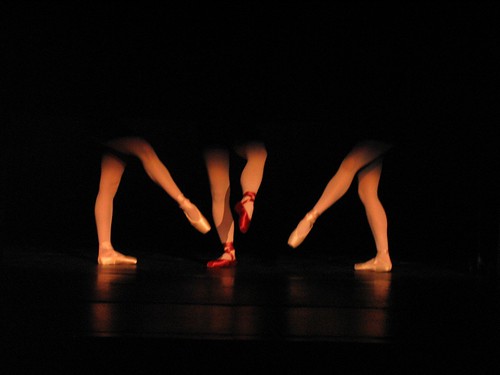
For lights in "Swan Lake", I just used a light pink color, to bring out the pink and red tones in the shoes. I used no side lighting because I didn't want to light up anything but the legs, and side lights would have allowed the audience to see bits of the stage and things behind the dancers. I used two Source 4's from the balcony rail, and shuttered them so that they both made squares of light on the box.
Once the pointe shoes finished, the light went back to the dancer sitting on the apron while the dancers changed costumes for the next dance. The curtain went back up to reveal the same box, but this time the music was reminiscent of orca whales, and the dancers clad in mottled blue-green tights. The went floating across the box, using two parallel bars out of side of the audience. Here's a picture of what we called "Whales":
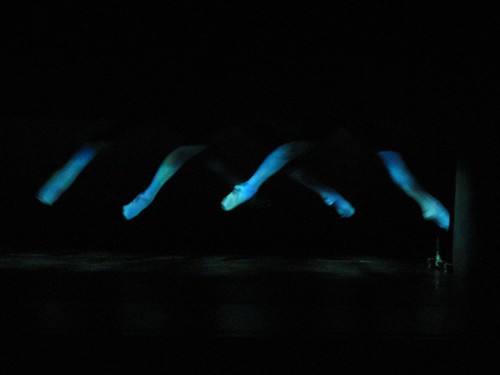
For lights in this I also used Source 4's from the balcony rail, but this time I used two different colors: a blue-green and a green-blue. They were close in color, but I like to think that they helped accentuate the costumes, although it's hard to tell. I also used gobo scrollers in each light, set at a very low level, so that there was actually a mottled pattern to the light which slowly changed and shifted throughout the piece. I doubt anyone noticed it, but when I didn't have the gobo scrollers working, there was definitely a static quality to the light which I didn't like.
Lastly, the light when back to the dancer on the apron, but this time her light stayed up as the curtain went up on a full stage. The dancers were clad in rehearsal clothing, and the music was a tentative piano piece. Every so often, snippets of a symphonic string piece could be heard fading through the piano music. Each time this happened, I brought the lights up a bit, so the brightness was gradually increasing throughout. At the end, the dancers took off their rehearsal costumes to reveal full performance dresses. Then the piano disappeared, the symphony music began, and it was time for the "real" performance. For this, I brought most all of the lights up to full blast.
I don't have pictures of the interim parts, but I do have shots of the full performance lighting. Here are a few:
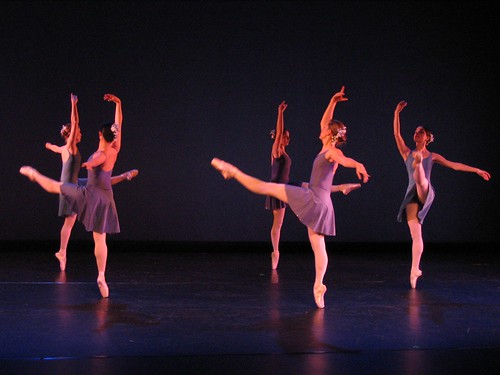
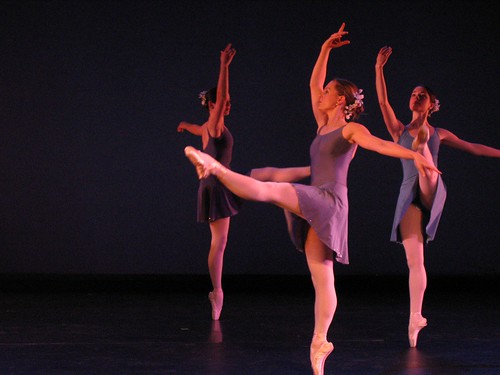
This photo, incidentally, is a good look at how light can give shape and definition to a person. Take a look at the front most dancer. First, look at the leg she is standing on. Notice that the right (stage left) side of her leg has a bit of extra brightness to it, but overall, the leg is essentially illuminated the same amount over its entire visible area, left-to-right.
Now, look at her upraised arm. See how both sides are significantly brighter than the center, and there is a long, smooth gradient between light and dark areas. This gives the arm shape and definition--you know it's an arm, instead of just a flat piece of cardboard shaped like an arm, because those shadows exist because of the three-dimensional shape of the arm.
Ideally, in a dance, you want everything to be shaded like her arm, not like her legs. However, many choreographers want lots of "face light"--frontal illumination, so you can see the dancers' faces. Sadly, frontal illumination "flattens" dancers by making them look like cutouts. It's kind of a compromise between light designer and choreographer as to how much face light there is, sometimes. In this case, the dancer's upraised arm is above the level of the front lights, while her leg is right in it, so the leg is flat while the arm is shaped.
I actually think the front light worked well in this case--this dance was very much about the stereotypes and clichés of pointe ballet, so making the dancers look somewhat flat and two-dimensional actually gave the piece a nice effect.
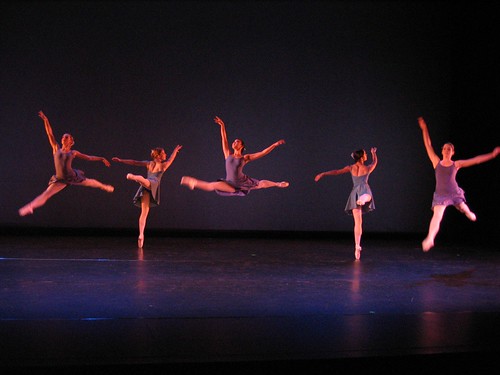
I love this photo.
Anyway, for this dance I used plenty of front light, at Christine's request. I also used blue "cyc" (short for cyclorama) lights on the back to set off the shape of the dancers. Then I used warm side lights to give them that definition I talked about earlier. Finally, since the front light tended to wash out the blue on the cyc, I added some pretty bright blue back lights, which gave all the dancers a subtle blue halo. You can see it in some of the pictures if you look closely (you'll probably have to look at the large versions). I also used blue and yellow high side lights, which added to the kind of definition the sidelights gave.
And that's that. I'll post stuff on
Ipi Zombi when I get the chance.
 For lights in "Swan Lake", I just used a light pink color, to bring out the pink and red tones in the shoes. I used no side lighting because I didn't want to light up anything but the legs, and side lights would have allowed the audience to see bits of the stage and things behind the dancers. I used two Source 4's from the balcony rail, and shuttered them so that they both made squares of light on the box.
Once the pointe shoes finished, the light went back to the dancer sitting on the apron while the dancers changed costumes for the next dance. The curtain went back up to reveal the same box, but this time the music was reminiscent of orca whales, and the dancers clad in mottled blue-green tights. The went floating across the box, using two parallel bars out of side of the audience. Here's a picture of what we called "Whales":
For lights in "Swan Lake", I just used a light pink color, to bring out the pink and red tones in the shoes. I used no side lighting because I didn't want to light up anything but the legs, and side lights would have allowed the audience to see bits of the stage and things behind the dancers. I used two Source 4's from the balcony rail, and shuttered them so that they both made squares of light on the box.
Once the pointe shoes finished, the light went back to the dancer sitting on the apron while the dancers changed costumes for the next dance. The curtain went back up to reveal the same box, but this time the music was reminiscent of orca whales, and the dancers clad in mottled blue-green tights. The went floating across the box, using two parallel bars out of side of the audience. Here's a picture of what we called "Whales":
 For lights in this I also used Source 4's from the balcony rail, but this time I used two different colors: a blue-green and a green-blue. They were close in color, but I like to think that they helped accentuate the costumes, although it's hard to tell. I also used gobo scrollers in each light, set at a very low level, so that there was actually a mottled pattern to the light which slowly changed and shifted throughout the piece. I doubt anyone noticed it, but when I didn't have the gobo scrollers working, there was definitely a static quality to the light which I didn't like.
Lastly, the light when back to the dancer on the apron, but this time her light stayed up as the curtain went up on a full stage. The dancers were clad in rehearsal clothing, and the music was a tentative piano piece. Every so often, snippets of a symphonic string piece could be heard fading through the piano music. Each time this happened, I brought the lights up a bit, so the brightness was gradually increasing throughout. At the end, the dancers took off their rehearsal costumes to reveal full performance dresses. Then the piano disappeared, the symphony music began, and it was time for the "real" performance. For this, I brought most all of the lights up to full blast.
I don't have pictures of the interim parts, but I do have shots of the full performance lighting. Here are a few:
For lights in this I also used Source 4's from the balcony rail, but this time I used two different colors: a blue-green and a green-blue. They were close in color, but I like to think that they helped accentuate the costumes, although it's hard to tell. I also used gobo scrollers in each light, set at a very low level, so that there was actually a mottled pattern to the light which slowly changed and shifted throughout the piece. I doubt anyone noticed it, but when I didn't have the gobo scrollers working, there was definitely a static quality to the light which I didn't like.
Lastly, the light when back to the dancer on the apron, but this time her light stayed up as the curtain went up on a full stage. The dancers were clad in rehearsal clothing, and the music was a tentative piano piece. Every so often, snippets of a symphonic string piece could be heard fading through the piano music. Each time this happened, I brought the lights up a bit, so the brightness was gradually increasing throughout. At the end, the dancers took off their rehearsal costumes to reveal full performance dresses. Then the piano disappeared, the symphony music began, and it was time for the "real" performance. For this, I brought most all of the lights up to full blast.
I don't have pictures of the interim parts, but I do have shots of the full performance lighting. Here are a few:

 This photo, incidentally, is a good look at how light can give shape and definition to a person. Take a look at the front most dancer. First, look at the leg she is standing on. Notice that the right (stage left) side of her leg has a bit of extra brightness to it, but overall, the leg is essentially illuminated the same amount over its entire visible area, left-to-right.
Now, look at her upraised arm. See how both sides are significantly brighter than the center, and there is a long, smooth gradient between light and dark areas. This gives the arm shape and definition--you know it's an arm, instead of just a flat piece of cardboard shaped like an arm, because those shadows exist because of the three-dimensional shape of the arm.
Ideally, in a dance, you want everything to be shaded like her arm, not like her legs. However, many choreographers want lots of "face light"--frontal illumination, so you can see the dancers' faces. Sadly, frontal illumination "flattens" dancers by making them look like cutouts. It's kind of a compromise between light designer and choreographer as to how much face light there is, sometimes. In this case, the dancer's upraised arm is above the level of the front lights, while her leg is right in it, so the leg is flat while the arm is shaped.
I actually think the front light worked well in this case--this dance was very much about the stereotypes and clichés of pointe ballet, so making the dancers look somewhat flat and two-dimensional actually gave the piece a nice effect.
This photo, incidentally, is a good look at how light can give shape and definition to a person. Take a look at the front most dancer. First, look at the leg she is standing on. Notice that the right (stage left) side of her leg has a bit of extra brightness to it, but overall, the leg is essentially illuminated the same amount over its entire visible area, left-to-right.
Now, look at her upraised arm. See how both sides are significantly brighter than the center, and there is a long, smooth gradient between light and dark areas. This gives the arm shape and definition--you know it's an arm, instead of just a flat piece of cardboard shaped like an arm, because those shadows exist because of the three-dimensional shape of the arm.
Ideally, in a dance, you want everything to be shaded like her arm, not like her legs. However, many choreographers want lots of "face light"--frontal illumination, so you can see the dancers' faces. Sadly, frontal illumination "flattens" dancers by making them look like cutouts. It's kind of a compromise between light designer and choreographer as to how much face light there is, sometimes. In this case, the dancer's upraised arm is above the level of the front lights, while her leg is right in it, so the leg is flat while the arm is shaped.
I actually think the front light worked well in this case--this dance was very much about the stereotypes and clichés of pointe ballet, so making the dancers look somewhat flat and two-dimensional actually gave the piece a nice effect.
 I love this photo.
Anyway, for this dance I used plenty of front light, at Christine's request. I also used blue "cyc" (short for cyclorama) lights on the back to set off the shape of the dancers. Then I used warm side lights to give them that definition I talked about earlier. Finally, since the front light tended to wash out the blue on the cyc, I added some pretty bright blue back lights, which gave all the dancers a subtle blue halo. You can see it in some of the pictures if you look closely (you'll probably have to look at the large versions). I also used blue and yellow high side lights, which added to the kind of definition the sidelights gave.
And that's that. I'll post stuff on Ipi Zombi when I get the chance.
I love this photo.
Anyway, for this dance I used plenty of front light, at Christine's request. I also used blue "cyc" (short for cyclorama) lights on the back to set off the shape of the dancers. Then I used warm side lights to give them that definition I talked about earlier. Finally, since the front light tended to wash out the blue on the cyc, I added some pretty bright blue back lights, which gave all the dancers a subtle blue halo. You can see it in some of the pictures if you look closely (you'll probably have to look at the large versions). I also used blue and yellow high side lights, which added to the kind of definition the sidelights gave.
And that's that. I'll post stuff on Ipi Zombi when I get the chance.